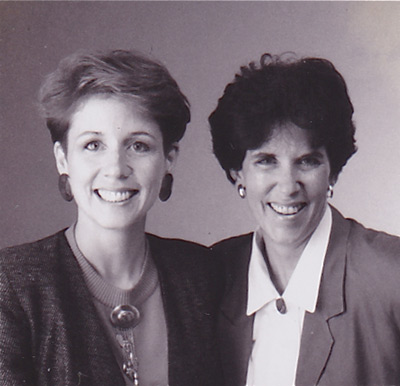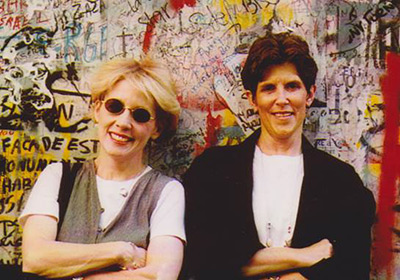Objects May Be Closer Than They Appear
by Ginny Hoyle and Connie Asher

Ginny & Connie back in the day

Ginny & Connie back in the day
Marian Halliday, recipient of the 2011 AIGA Colorado Fellow award, asked her fellow Fellows to reflect back on 25 years of design in Colorado. First up are Connie Asher and Ginny Hoyle. Here’s what the ladies had to say:
Connie: So much has changed in 25 years. The 90s brought the advent of the World Wide Web, HTML, Quark Xpress, email and explosive economic growth. Today, Colorado’s population growth rate is double the national average, but our working years weathered cycles of boom and bust. After the big slump in the mid-80s, Denver began to become the city Federico Pena dared voters to imagine. And then came the new millennium. We worried about Y2K for nothing, but…
2001. It was an awful year for business, opening as it did with the dawning awareness that history’s longest, wildest economic party was really over and ending with the confused anguish of September 11 and its aftermath. Creative caution characterized the state of design early in the year, as Americans collectively shrugged off the excesses of boom times. By year’s end many designers were openly questioning the value—even the relevance—of their work… –Lana Rigsby, AIGA 365 Number 23
Ginny: In this way, communication is always shaped by forces bigger than us. It’s sobering. Fascinating. And easier to see clearly in the rear view mirror. So we learned what every generation learns—keep up. Adapt. Stay in front of something nameless that keeps changing its shape. For designers today, change is happening faster than ever.
On a lighter note, think about how much fell away in our working years—the clack of typewriters, whiteout, carbon paper—the messy reality that gave us the term “cc.” And bigger things—the art of setting type, as trays of hot metal melted into keystrokes. I like to think Gutenberg is rolling in his grave and talking fonts with Steve Jobs.
Connie: So true. We lost Rubylith. Exacto knives. Lettraset. We saved our lungs by getting rid of fixative. A “work station” used to be an elevated drawing board with a tall stool and a serious-looking adjustable lamp. Now it’s a laptop in a cubicle or coffee shop.
Moving from hand to digital opened up the creative process and accelerated the production side. Digital tools brought more experimentation because we could see the real thing. It was exciting. Options were endless. We loved the ease of change and revision. And we hated it. Endless visual options can get in the way of the real idea, bury the best idea. Nothing good comes from showing client 12 options.
Ginny: The e-world made writing a faster, freer process. It eliminated tedious retyping. But everything speeded up, didn’t it? Clients began to expect rewrites overnight. Desktops and laptops opened up endless rounds of minor revision that could improve the copy—or just sand off the edginess that made it interesting and fresh.
Connie: So designers today need a fast keen eye, an intellectual machete, in a way, to cull options and give clients the solutions that work. Design trends come and go, but that’s the huge challenge, a pressing reality.
Ginny: That’s true for copy, too. I wonder if copywriters can still persuade clients to give them the time they need to do the interviews and ask the hard questions that enable a writer to penetrate the layers of jargon and get to the core story that reveals concept and everything that flows from that. Oh, well. Pick an era. The clock is always the enemy. The hurrier we go, the behinder we get, as my mother used to say.
Speaking of design trends—let’s do a lightning round on the good, the bad and the ugly from our years together. Ready. Set. Go!
The good: Optima. A font for a lifetime. The bad: Teeny tiny type in mixed fonts or all caps that is just impossible to read. The boring: Hunter green. Every CEO wanted hunter green. And just plain ugly: Mauve and gray, like the beautiful Midnight Oil promo Connie designed for me in 1985. It was so brilliantly gorgeously fabulous—then.
Connie: The good: Tibor Kalman, Ikonofix dull paper by Zanders, beautiful brochure comps made with our Epson printer that we could never replicate in print and valentines. The bad: Never charging enough for the typesetting we were now doing.
Ginny: Above all, I remember the excitement of working in a business that let me look behind the scenes to see how a city grows up. And all the good smart people who led the way and let me into the process. It grew me up, too. They say (they-who??) best friends can’t do business together, but our friendship is what made us reach deep for the client, the solution, and each other. I remember late nights and short weekends but I also remember the thrill of getting it right and the satisfaction of that shared success.
My favorite take-away memory has nothing to do with design trends, really, except that we were the generation that couldn’t wait to bring home the bacon, fry it up in a pan and never let you forget you’re a man. (Oh, my.) I remember Connie in her first free-lance days, calling on Barnhart with her daughter Kelly in a backpack. And then me, attending my last client meeting for Safari Africa in Connie’s office on 17th Avenue, with my granddaughter, Gwen, in a front pack. And Gwen was not sleeping peacefully, but squealing and doing jumping jacks, putting in her two cents. There’s room for improvement, but it’s a better world for working women now.
Connie: Above all I still remember the exhilaration and wonder of landing a big project. And then the despair when you realize you don’t know what to do with it a week later. I remember presenting a great solution to a client and being shot down. I remember enjoying what I did so much, especially the hand work of the design process—those early days filled with paper and markers and exacto knives and comps that had to sell your idea to your client. And the people. The best writers, photographers, designers, paper reps and printers. The Colorado design community was a close knit, competitive-but-friendly place to do business. The best.
On a more personal note; Ginny and I worked together as a team for over 30 years. We wrote and designed scores of projects.
We locked ourselves out of a car at a meeting in Colorado Springs one day and found a way for a locksmith to open it up without letting our client know. We did a brochure on trade out with a client and ended up in San Diego Harbor on a yacht for four days eating lobster. We got lost a few times on our way to meetings during great free-wheeling conversations—we didn’t have GPS to navigate for us. But we always found our way in the end. And it was a great ride.
Change is complicated. But most of the changes we’ve seen and survived were good ones and gave us more freedom and fresh forms of creative expression.
Here’s to the next 25 and the Colorado design talent who will lead the way!